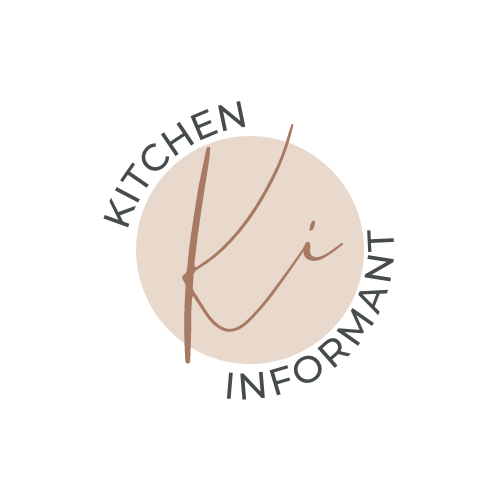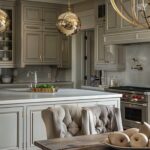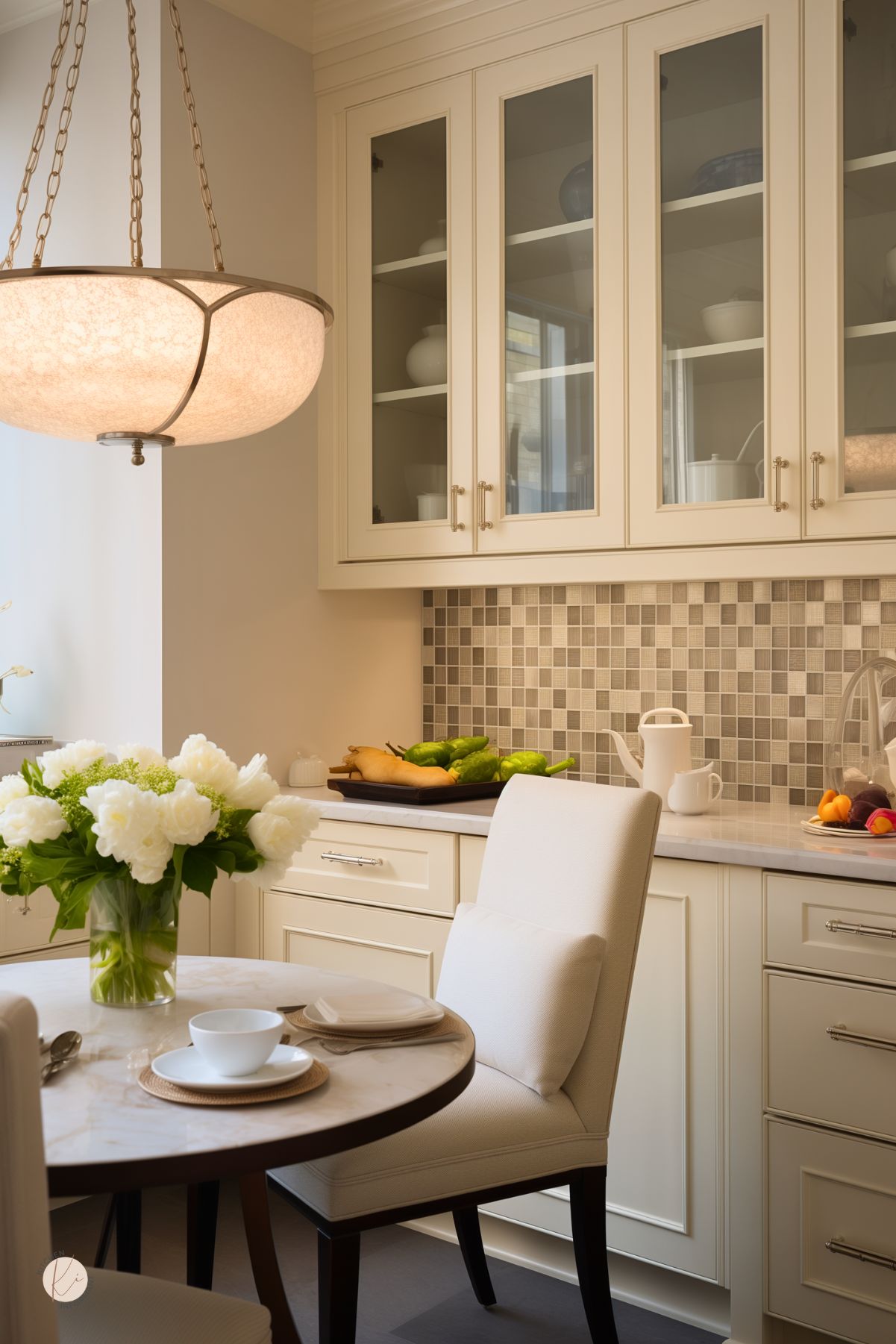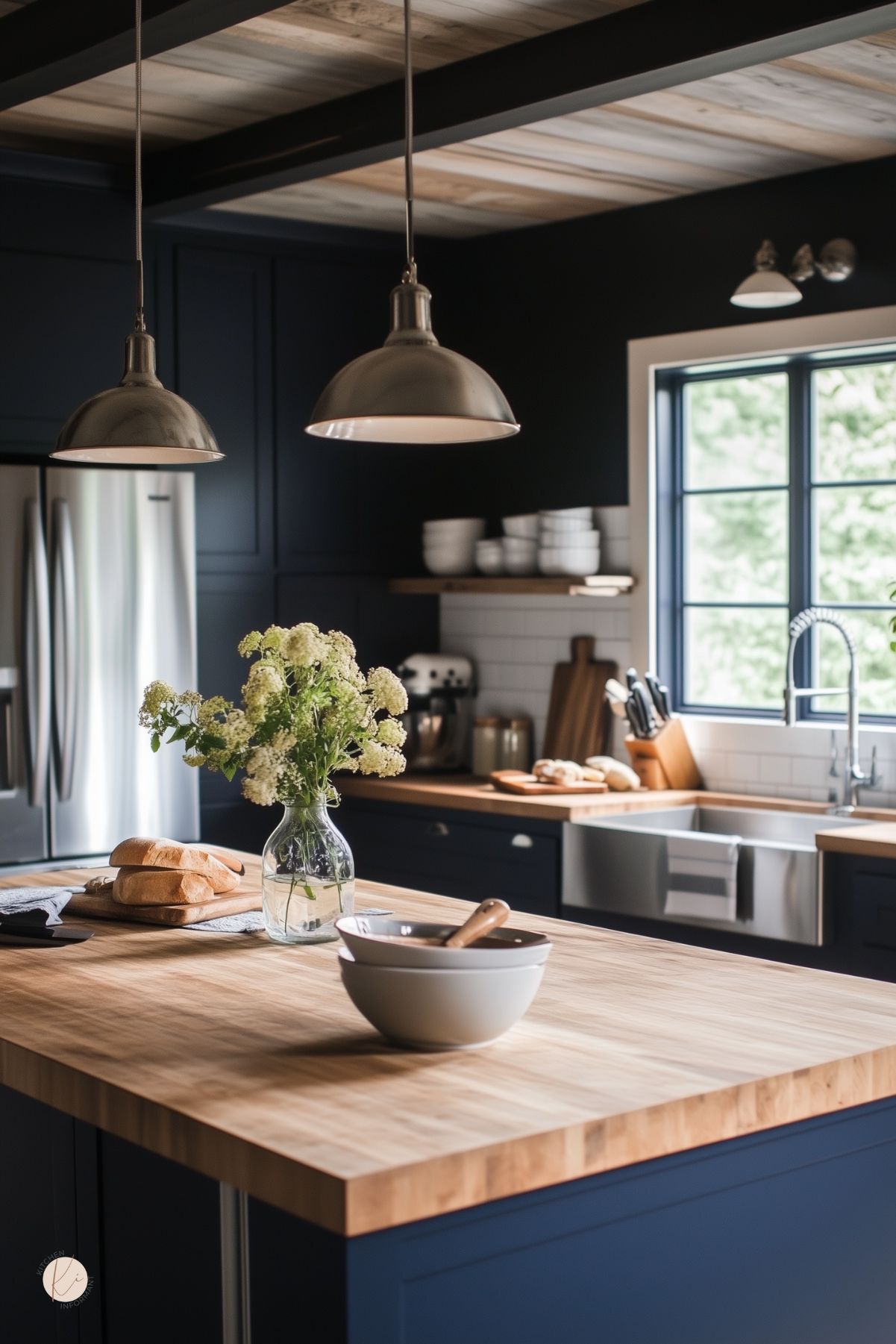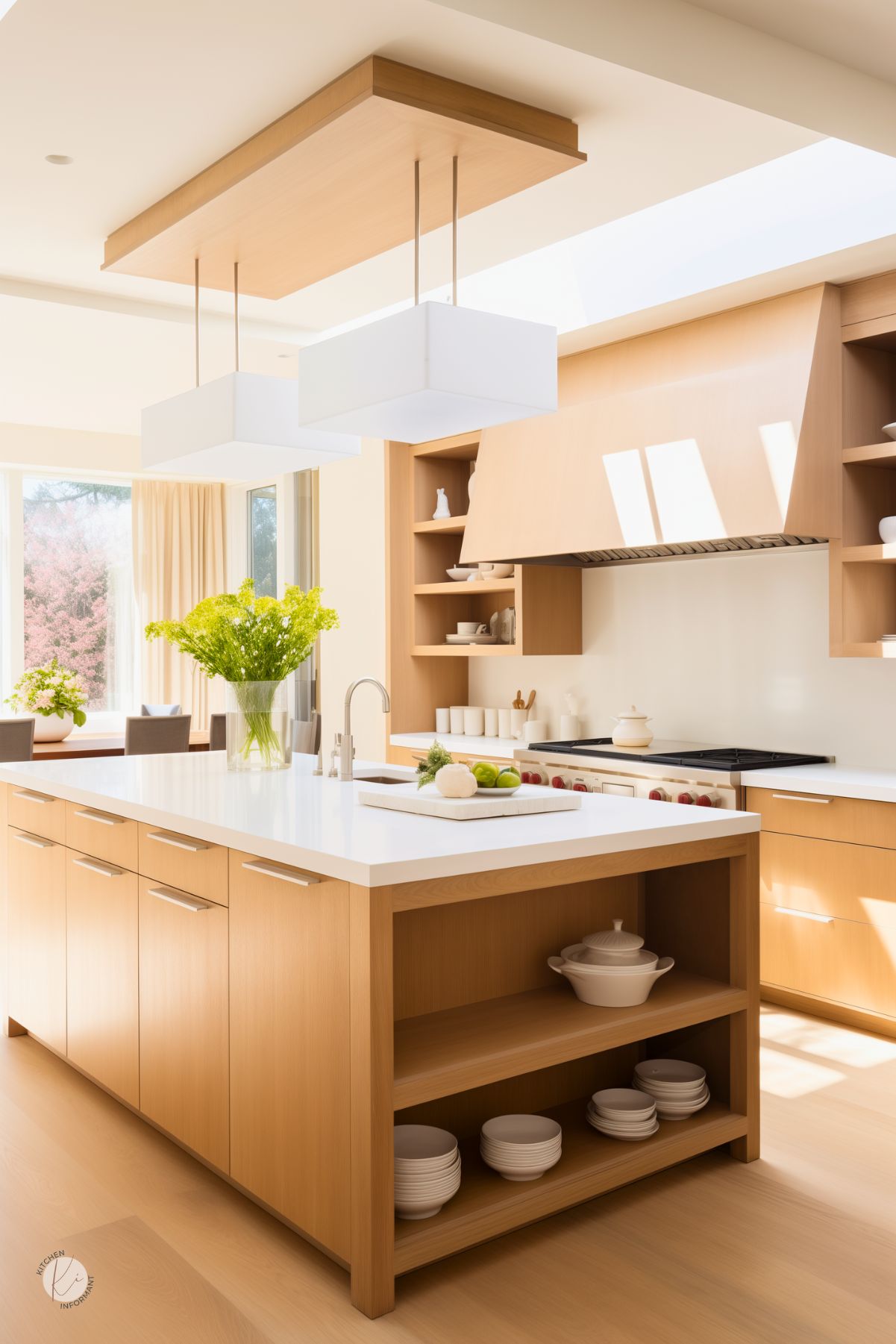The 1970s was an era of bold and unique design choices that left a lasting impact on interior design. One area that particularly stands out is the kitchen.
From bright colors to unique appliances, the 1970s kitchen was a reflection of the changing times and the desire for individuality.

In this article, we will take a trip down memory lane and revisit the iconic 1970s kitchen design trends. We will explore the colors, patterns, layouts, and appliances that defined the era, and how they have influenced modern kitchen design.
Whether you’re a fan of the retro look or simply curious about the past, this article is sure to provide an interesting glimpse into the world of 1970s kitchen design.
The Heart of the Home: 1970s Kitchen Design Fundamentals

The kitchen is often considered the heart of the home, and in the 1970s, it was no different. The 1970s kitchen was a vibrant and functional space that was designed to meet the needs of the modern family.
Here are some of the fundamental design elements that defined the era:
Color Scheme
The 1970s kitchen was all about bold and bright colors.
Avocado green, burnt orange, mustard yellow, and brown were some of the most popular colors used in kitchen design. These colors were often used in combination with each other to create a lively and vibrant space.
Appliances
The 1970s saw the rise of new kitchen appliances that were designed to make cooking and cleaning easier.
Microwave ovens, dishwashers, and garbage disposals became more common, and refrigerators became larger and more efficient.
Cabinetry
Cabinetry in a 1970s kitchen often featured wood tones and textured finishes. Darker wood was popular, and paneling was used to add depth and interest.
Open shelving was another trend, allowing homeowners to display their favorite dishes and cookware.
Flooring
Linoleum was the go-to flooring material for 1970s kitchens. It was durable, easy to clean, and available in a wide range of colors and patterns.
Many homeowners also opted for wall-to-wall carpeting in their kitchens, which was not as practical but added warmth and comfort to the space.
Lighting
Lighting was an important aspect of 1970s kitchen design.
Recessed lighting and track lighting became more popular, providing homeowners with more options for illuminating their kitchens. Pendant lighting was also used to add a decorative touch to the space.
Overall, the 1970s kitchen was a functional and stylish space that reflected the needs and tastes of the era.
While some design elements may seem outdated today, many of the fundamental principles of 1970s kitchen design continue to influence modern kitchen design trends.
Color Me Retro: Popular Palettes and Patterns

The 1970s was a decade of bold and unique design choices, and this was reflected in the color palettes and patterns used in kitchen design.
Earth tones such as brown, beige, rust, and olive green were the dominant colors in fashion, interior design, and even graphic design.
These colors were often used in combination with wooden elements to create a balanced and visually appealing look.
In addition to earth tones, bright and bold colors were also popular in 1970s kitchen design.
Avocado green, harvest gold, and burnt orange were some of the most iconic colors of the era. These colors were often used for appliances, countertops, and even cabinetry.
When it came to patterns, geometric shapes and bold prints were in vogue.
Checkerboard patterns, stripes, and polka dots were popular choices for flooring, while wallpaper featuring large floral or abstract patterns was often used on walls.
Overall, 1970s kitchen design was all about making a statement with color and pattern.
While some of the choices may seem dated today, there is no denying the impact that this era had on kitchen design and the lasting influence it continues to have.
Formica and Funk: Iconic Materials of the ’70s Kitchen

The 1970s was a decade of bold design choices, and the kitchen was no exception.
One of the most iconic materials used in ’70s kitchens was Formica laminate. Formica was invented in 1912 by two electrical engineers who were looking for a new insulation material. However, it wasn’t until the 1950s that Formica became popular as a material for countertops.
In the ’70s, Formica countertops came in a variety of bold patterns and colors that perfectly captured the spirit of the era.
From the psychedelic swirls of “Skylark” to the earthy tones of “Autumn Leaves,” Formica countertops were a key element in creating the funky, retro look of ’70s kitchens.
But Formica wasn’t just limited to countertops. It was also used for kitchen tables, cabinets, and even walls.
In fact, Formica walls were a popular choice for those who wanted a low-maintenance, easy-to-clean kitchen.
Another iconic material of ’70s kitchen design was wood paneling.
Wood paneling was used on walls, ceilings, and even cabinets. It gave kitchens a warm, cozy feel and was often paired with other ’70s design elements like shag carpeting and macrame.
In conclusion, Formica and wood paneling were two of the most iconic materials used in ’70s kitchen design.
They perfectly captured the bold, funky spirit of the era and helped to create some of the most memorable kitchen designs of all time.
Appliance Evolution: Tech and Trends of the Decade

The 1970s was a decade of significant technological advancements in the kitchen. The introduction of new appliances revolutionized the way people cooked and prepared food.
Here are some of the most popular kitchen appliances and trends of the decade:
Microwave Ovens
Microwave ovens were first introduced in the 1960s, but it wasn’t until the 1970s that they became more affordable and accessible to the general public.
By the end of the decade, almost every household had a microwave oven. This appliance allowed for quick and easy cooking, reheating, and defrosting of food.
Dishwashers
Dishwashers became more common in the 1970s, and they were a significant improvement over hand-washing dishes.
They not only saved time but also water and energy. By the end of the decade, dishwashers had become more affordable and were a standard feature in most new homes.
Trash Compactors
Trash compactors were a popular appliance in the 1970s. They allowed for more efficient disposal of waste by compressing it into smaller, more manageable pieces.
This appliance was especially popular in urban areas where space was limited.
Avocado Green and Harvest Gold
The 1970s was also known for its unique color schemes, and this trend extended to kitchen appliances.
Avocado green and harvest gold were the most popular colors for appliances in the decade. Refrigerators, stoves, and dishwashers were all available in these trendy colors.
Overall, the 1970s was a decade of significant advancements in kitchen technology.
The introduction of new appliances like microwave ovens, dishwashers, and trash compactors made cooking and cleaning more efficient and convenient. The trend of unique color schemes also added a touch of personality to kitchen design.
Space-Saving Solutions: Compact Designs and Modular Units

The 1970s was a decade of change, and kitchen design was no exception.
As homes became smaller and more compact, designers looked for ways to maximize space in the kitchen. This led to the development of space-saving solutions such as compact designs and modular units.
One popular design trend was the galley kitchen, which featured a narrow layout with cabinets and appliances on either side.
This design was ideal for small spaces, as it allowed for efficient use of space while still providing all the necessary appliances and storage.
Another space-saving solution was the use of modular units.
These units were designed to be easily moved and reconfigured, so homeowners could adapt their kitchen to their changing needs.
For example, a modular unit might include a sink, countertop, and storage, all in one compact package.
In addition to modular units, designers also looked for ways to make appliances more compact.
This led to the development of smaller refrigerators, dishwashers, and ovens, all of which could be easily integrated into a compact kitchen design.
Overall, the 1970s was a decade of innovation in kitchen design, as designers looked for ways to maximize space without sacrificing functionality.
Today, many of these space-saving solutions are still in use, proving that good design never goes out of style.
Groovy Gadgets and Accessories

The 1970s were a time of innovation and creativity in kitchen gadgetry. From avocado green blenders to funky patterned dish towels, the era was all about adding a touch of fun and personality to the heart of the home.
One of the most iconic gadgets of the 1970s was the fondue pot. This communal cooking device was perfect for hosting parties and entertaining guests.
It allowed people to dip everything from bread to fruit in melted cheese or chocolate, making for a fun and interactive dining experience.
Today, fondue pots are still a popular choice for those looking to recreate that retro vibe in their homes.
Another popular gadget of the era was the electric can opener. This device made it easy to open cans without having to use a manual can opener.
It was a convenient tool that saved time and effort in the kitchen.
Today, electric can openers are still widely used and can be found in a variety of colors and designs to match any kitchen decor.
In addition to gadgets, accessories were also an important part of 1970s kitchen design.
One popular accessory was the dish towel. These towels often featured bold patterns and bright colors, adding a pop of fun to the kitchen.
Another popular accessory was the bread box. These boxes were used to store bread and other baked goods, and often featured a sleek and modern design.
Overall, the 1970s were a time of innovation and fun in kitchen design. From fondue pots to dish towels, the era was all about adding personality and flair to the heart of the home.
Lighting the Way: 1970s Fixtures and Ambience

The 1970s was a decade of bold choices and unique design elements that left a lasting impression on the world of interior design.
Lighting played a crucial role in setting the mood of a space, and in a 70s-inspired kitchen, it was no different.
To enhance the groovy atmosphere, retro lighting fixtures were incorporated. Pendant lights, chandeliers, or sconces with retro shapes and materials like brass or colored glass were popular choices.
These fixtures not only provided ample illumination but also added a touch of nostalgia to the kitchen.
In addition to lighting fixtures, natural light was also an important element in 70s kitchen design.
Large windows and skylights were popular features that allowed natural light to flood the space.
This not only created a bright and airy atmosphere but also helped to bring the outdoors in.
Overall, lighting played a significant role in creating the perfect ambience in 70s kitchen design.
By incorporating retro lighting fixtures and maximizing natural light, homeowners were able to create a groovy and inviting space that was perfect for cooking, entertaining, and making memories.
From Floors to Doors: Flooring and Cabinetry Styles

When it comes to 1970s kitchen design, specific flooring and cabinetry styles were popular.
One of the most common flooring options was linoleum, which was often found in bold colors and patterns. This was a durable and cost-effective option that could withstand the heavy foot traffic of a busy kitchen.
Another popular flooring option was vinyl, which was also available in a wide range of colors and patterns.
Cabinetry styles in the 1970s were often characterized by their dark wood finishes and ornate details.
Many cabinets featured intricate carvings and moldings, as well as decorative hardware.
Some popular wood choices for cabinetry included oak, cherry, and mahogany.
However, the 1970s also saw the rise of laminate cabinets, which were a more affordable option and could mimic the look of wood.
In addition to wood and laminate, metal cabinets were also popular in the 1970s.
Stainless steel cabinets were often used in commercial kitchens, but they also found their way into residential kitchens.
These cabinets were prized for their durability and sleek, modern look.
When it came to cabinet hardware, the 1970s saw a move away from traditional knobs and pulls.
Instead, many cabinets featured long, horizontal handles that ran the length of the door or drawer. These handles were often made of metal and had a sleek, modern look.
Overall, the flooring and cabinetry styles of the 1970s were characterized by bold colors, ornate details, and a mix of traditional and modern elements.
While some of these styles may seem outdated today, they continue to inspire designers and homeowners looking to create a retro look in their kitchens.
Seating and Dining: Tables, Chairs, and Bar Stools

The 1970s were a time of experimentation and innovation in kitchen design, and this was reflected in the furniture choices as well.
The era saw a departure from the formal dining rooms of the past, with more emphasis placed on comfortable and casual dining spaces within the kitchen.
Tables
Kitchen tables in the 1970s were often made of wood and featured simple, clean lines.
Oval and round tables were popular choices, as were tables with drop leaves that could be expanded when needed.
Some tables even had built-in benches for a more casual dining experience.
Chairs
Chairs in the 1970s were often upholstered in bright, bold colors and patterns, adding a pop of color to the kitchen.
Many chairs featured padded seats and backs for added comfort.
Some chairs also had swivel bases, allowing for easy movement around the table.
Bar Stools
Bar stools were a popular addition to 1970s kitchens, particularly those with a breakfast bar or island.
Bar stools were often made of chrome and vinyl, with bright colors and patterns to match the chairs.
Some bar stools even had adjustable heights and footrests for added comfort.
Overall, the 1970s were a time of experimentation and innovation in kitchen design, and the furniture choices reflected this.
Comfortable and casual dining spaces were favored over formal dining rooms, and furniture was designed with both style and comfort in mind.
Wall Decor and Artwork: Personalizing Your Space

The 1970s was a decade of bold and unique design elements that left a lasting impression on the world of interior design.
One of the defining features of 1970s kitchen design was the use of wall decor and artwork to add personality and character to the space.
To recreate the groovy vibe of a 1970s kitchen, consider incorporating bold and colorful wall decor.
This could include vintage posters, psychedelic wallpaper, or even a gallery wall of retro artwork.
Don’t be afraid to mix and match patterns and colors to create a truly unique and eclectic space.
Another popular trend in 1970s kitchen design was the use of macrame plant hangers to add texture and visual interest to the walls.
These can be hung from the ceiling or mounted on the walls to create a bohemian vibe that is both stylish and functional.
If you’re looking for something a bit more subtle, consider adding a few small decor pieces to your kitchen walls.
This could include a collection of vintage plates, a colorful clock, or even a set of quirky kitchen utensils.
These small touches can go a long way in adding personality and charm to your space.
Overall, the key to creating a 1970s-inspired kitchen is to have fun with your decor and let your personality shine through.
Whether you opt for bold and colorful wallpaper or a collection of quirky kitchen utensils, the most important thing is to make your space your own.
The Legacy of 1970s Kitchens: Influence on Modern Design

The 1970s kitchen design trends have left a lasting impact on modern kitchen design.
Many elements of the 70s kitchen have been incorporated into today’s kitchens, creating a beautiful blend of retro and contemporary styles.
Color Palette
The bold and vibrant color palette of the 70s kitchen has made a comeback in modern kitchens.
The use of colors like burnt orange, mustard yellow, avocado green, and brown has become popular again.
However, instead of using these colors on everything, modern designers use them as accents to add interest and depth to the kitchen.
Textured Finishes
Textured finishes were a hallmark of 70s kitchen design. Wooden elements and darker wood tones were popular, and paneling was used to add depth and interest.
Modern kitchens have incorporated these elements in various ways, such as using wood paneling on the walls or adding wooden accents to the cabinets or island.
Open Shelving
Open shelving was another trend that originated in the 70s. It allowed homeowners to display their kitchenware and add a personal touch to the kitchen.
Modern kitchens have taken this trend to the next level by incorporating floating shelves or glass cabinets.
Appliances
The 70s kitchen was known for its iconic appliances, such as avocado green refrigerators and harvest gold ovens.
While these colors may not be as popular today, modern appliances have taken inspiration from the 70s designs.
Retro-style appliances with modern features have become popular, adding a touch of nostalgia to modern kitchens.
Overall, the 70s kitchen design has had a significant impact on modern kitchen design.
By incorporating elements of the past with contemporary styles, designers have created beautiful and functional kitchens that pay homage to the past while looking towards the future.









